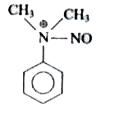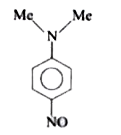Statement I: Aniline on reaction with at followed by coupling with -naphthol gives a dark blue coloured precipitate.
Statement II: The colour of the compound formed in the reaction of aniline with at followed by coupling with -naphthol is due to extended conjugation.
Statement (I) is true : Statement (II) is true : Statement (II) is the correct esplanation of Statement (I)
Statement (I) is true : Statement (II) is true , Statement (II) is not the correct exphanation fo sTatement (I)
Statement I is True, Statament II is false
Statement (I) is false , Statement (II) is true .
The correct Answer is:(d)
To analyze the given statements, let's break down the reactions and concepts involved step by step.
Step 1: Understanding the Reaction of Aniline with NaNO2 and HCl
Aniline (C6H5NH2) reacts with sodium nitrite (NaNO2) in the presence of hydrochloric acid (HCl) at low temperatures (0°C to 5°C). This reaction leads to the formation of benzene diazonium chloride (C6H5N2Cl).
Hint: Remember that diazonium salts are formed from primary amines in acidic conditions.
Step 2: Formation of Benzene Diazonium Chloride
The reaction can be summarized as follows:
C6H5NH2+NaNO2+HCl→C6H5N2Cl+NaCl+H2O
Here, aniline is converted to benzene diazonium chloride, which is a key intermediate in azo coupling reactions.
Hint: Focus on the role of sodium nitrite and HCl in converting aniline to a diazonium compound.
Step 3: Coupling with Beta-Naphthol
Next, the benzene diazonium chloride reacts with beta-naphthol (C10H7OH). This reaction occurs at low temperatures and results in the formation of an azo dye.
The coupling reaction can be represented as:
C6H5N2Cl+C10H7OH→C6H5N=N-C10H7OH+HCl
This forms an azo compound, which typically has a vivid color due to the presence of the azo (-N=N-) linkage.
Hint: Azo coupling reactions often produce colored compounds due to the extended conjugation of π-electrons.
Step 4: Color of the Azo Compound
The resulting azo compound from the coupling of benzene diazonium chloride with beta-naphthol is known to be orange-red in color, not dark blue as stated in Statement I. The color arises from the extended conjugation in the molecule, which allows for the absorption of visible light.
Hint: Recall that the color of organic compounds can often be attributed to their conjugated systems.
Step 5: Evaluating the Statements
- Statement I: Aniline on reaction with NaNO2 and HCl at 0°C followed by coupling with beta-naphthol gives a dark blue colored precipitate.
- This statement is incorrect because the product is orange-red, not dark blue.
- Statement II: The color of the compound formed in the reaction is due to extended conjugation.
- This statement is correct as the extended conjugation in the azo compound contributes to its color.
Conclusion
Thus, the correct evaluation of the statements is:
- Statement I is false.
- Statement II is true.
The final answer is that Statement I is incorrect while Statement II is correct.
Final Answer: Statement I is false, Statement II is true.
Aniline (C6H5NH2) reacts with sodium nitrite (NaNO2) in the presence of hydrochloric acid (HCl) at low temperatures (0°C to 5°C). This reaction leads to the formation of benzene diazonium chloride (C6H5N2Cl).
The reaction can be summarized as follows:
C6H5NH2+NaNO2+HCl→C6H5N2Cl+NaCl+H2O
Next, the benzene diazonium chloride reacts with beta-naphthol (C10H7OH). This reaction occurs at low temperatures and results in the formation of an azo dye.
C6H5N2Cl+C10H7OH→C6H5N=N-C10H7OH+HCl
The resulting azo compound from the coupling of benzene diazonium chloride with beta-naphthol is known to be orange-red in color, not dark blue as stated in Statement I. The color arises from the extended conjugation in the molecule, which allows for the absorption of visible light.
- Statement I: Aniline on reaction with NaNO2 and HCl at 0°C followed by coupling with beta-naphthol gives a dark blue colored precipitate.
- This statement is incorrect because the product is orange-red, not dark blue.
- This statement is correct as the extended conjugation in the azo compound contributes to its color.
Thus, the correct evaluation of the statements is:
- Statement I is false.
- Statement II is true.
Topper's Solved these Questions
- ORGANIC COMPOUNDS WITH FUNCTIONAL GROUPBOOK - CENGAGE CHEMISTRY ENGLISHCHAPTER - ORGANIC COMPOUNDS WITH FUNCTIONAL GROUPEXERCISE - Archives Multiple Correct
3 Videos
- ORGANIC COMPOUNDS WITH FUNCTIONAL GROUPBOOK - CENGAGE CHEMISTRY ENGLISHCHAPTER - ORGANIC COMPOUNDS WITH FUNCTIONAL GROUPEXERCISE - Archives Fill In The Blanks
3 Videos
- ORGANIC COMPOUNDS WITH FUNCTIONAL GROUPBOOK - CENGAGE CHEMISTRY ENGLISHCHAPTER - ORGANIC COMPOUNDS WITH FUNCTIONAL GROUPEXERCISE - Archives Single Correct
10 Videos
- NUCLEAR CHEMISTRYBOOK - CENGAGE CHEMISTRY ENGLISHCHAPTER - NUCLEAR CHEMISTRYEXERCISE - Archives Subjective
13 Videos
- P-BLOCK GROUP 15 ELEMENTS - THE NITROGEN FAMILYBOOK - CENGAGE CHEMISTRY ENGLISHCHAPTER - P-BLOCK GROUP 15 ELEMENTS - THE NITROGEN FAMILYEXERCISE - Exercises Archives (Subjective)
28 Videos
Similar Questions
Knowledge Check
Aniline react with NaNO2 and dil. HCl at 0−5∘C to form :
Ap-nitro anilineB2,4, 6-trinitroanilineCbenzene diazonium chlorideDbenzeneN,N-dimethyl aniline react with NaNO2 and dilute HCl at 0−5∘C to form :
A B
B C
C D
D
Compound (x)(m.f=C7H8N), on reaction with NaNO2 and conc. HCl at O∘C followed by β− naphthol gives orange coloured dye. Compound (x) is :
View Solution2-4 dinitroaniline is treated with NaNO2 and dilute HCI at 280 K followed by reaction with anisole , forming a coloured compound . The structure of this coloured compound would be :
View SolutionWhen aniline reacts with NaNO2 and dil. HCl at 0∘−%2C, the product formed is
View SolutionHow many toluidines on reaction with NaNO2/HCl followed by H3PO2 treatment gives Toluene.
View SolutionAmongst the compounds given, the one that would form a brilliant colored dye on treatment with NaNO2 in dil. HCl followed by addition to an alkaline solution of β−naphthol is
View SolutionWhich of the following compounds reacts with NaNO2 and HCl at 0-4∘C to give alcohol/phenol?
View Solution
